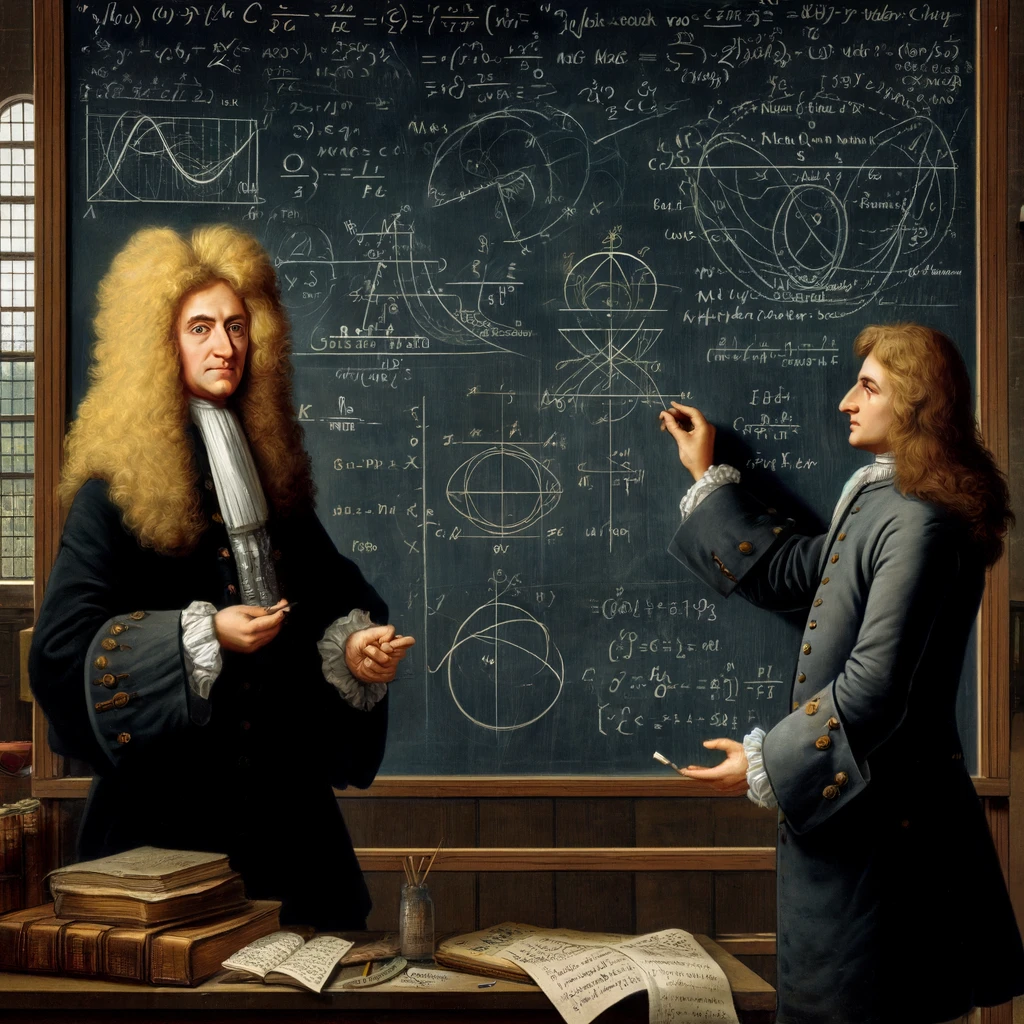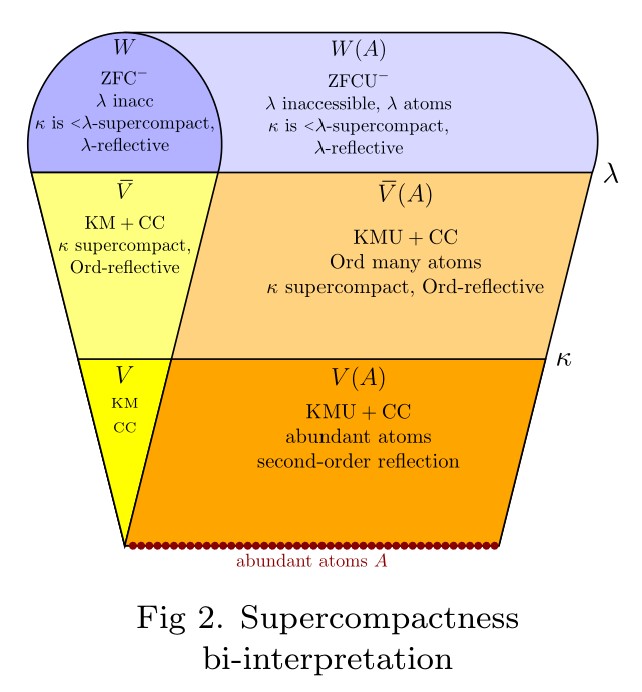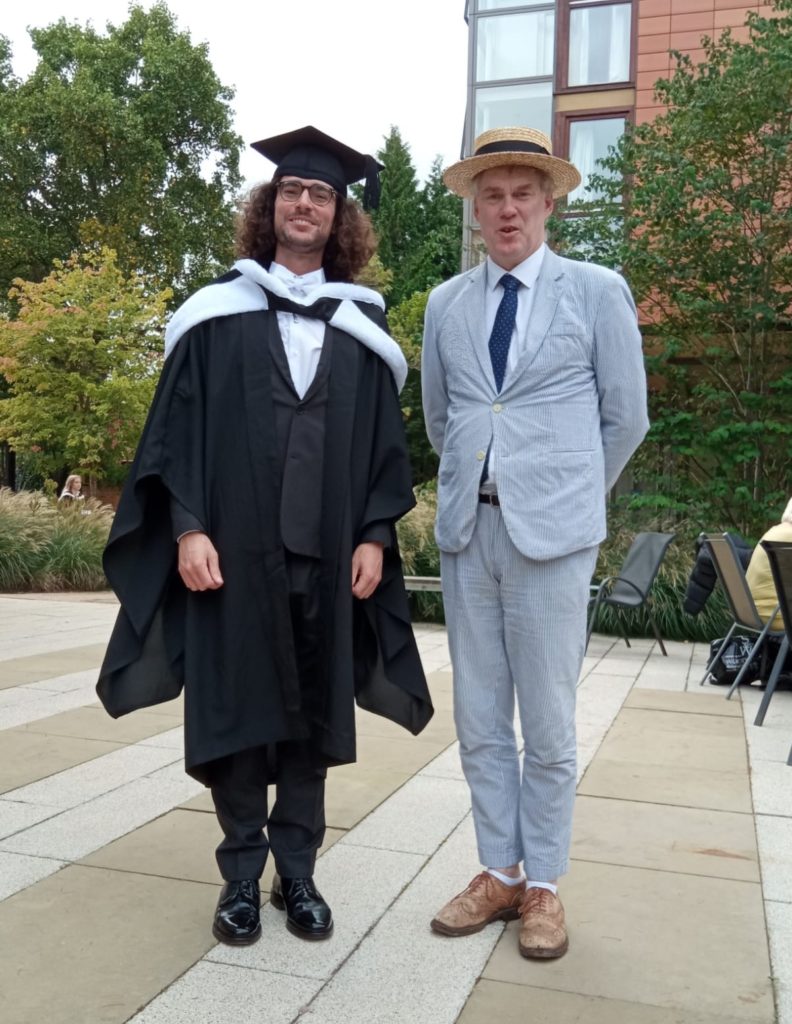This will be a talk for the Logic Seminar at the Mathematical Institute of the University of Oxford, 29 May 2025 5pm Andrew Wiles Building.

Abstract. For a given computably enumerable set

This will be a talk for the Logic Seminar at the Mathematical Institute of the University of Oxford, 29 May 2025 5pm Andrew Wiles Building.

Abstract. For a given computably enumerable set
This was a talk for the Philosophy of Mathematics Seminar at the University of Oxford, 19 May 2025.

Abstract. I shall describe a simple historical thought experiment showing how our attitude toward the continuum hypothesis could easily have been very different than it is. If our mathematical history had been just a little different, I claim, if certain mathematical discoveries had been made in a slightly different order, then we would naturally view the continuum hypothesis as a fundamental axiom of set theory, necessary for mathematics and indeed indispensable for calculus.

I shall be speaking on my paper: How the continuum hypothesis could have been a fundamental axiom
This will be a talk at the conference Challenging the Infinite, March 11-12 at Oxford University. (Please register now to book a place.)

Abstract Many commonly considered forms of potentialism, I argue, are implicitly actualist in the sense that a corresponding actualist ontology and theory is interpretable within the potentialist framework using only the resources of the potentialist ontology and theory. And vice versa. For these forms of potentialism, therefore, there seems to be little at stake in the debate between potentialism and actualism—the two perspectives are bi-interpretable accounts of the same underlying semantic content. Meanwhile, more radical forms of potentialism, lacking convergence and amalgamation, do not admit such a bi-interpretation with actualism. In light of this, the central dichotomy in potentialism, to my way of thinking, is not concerned with any issue of height or width, but rather with convergent versus divergent possibility.
This will be a talk for the Set Theory in the UK, STUK 10, held in Oxford 14 June 2023, organized by my students Clara List, Emma Palmer, and Wojciech Wołoszyn.

Abstract. I shall speak on the surprising strength of the second-order reflection principle in the context of set theory with abundant urelements. The theory GBcU with the abundant urelement axiom and second-order reflection is bi-interpretable with a strengthening of KM with a supercompact cardinal. This is joint work with Bokai Yao.


Abstract. There is an unexplained logical mystery in the foundations of mathematics, namely, our best and strongest mathematical theories seem to be linearly ordered and indeed well-ordered by consistency strength. Why should it be? The phenomenon is thought to carry significance for foundations, perhaps pointing us, some have argued, toward the ultimately correct mathematical theories, the “one road upward.” And yet, we know as a purely formal matter that the hierarchy of consistency strength is not well-ordered. It is ill-founded, densely ordered, and nonlinear. The statements commonly used to illustrate these features, however, are often dismissed as unnatural or as Gödelian trickery. In this talk, however, I aim to rebut that criticism by presenting a variety of natural hypotheses that reveal illfoundedness in consistency strength, density in the hierarchy of consistency strength, and incomparability in consistency strength. This will lead to discussion of the role and meaning of “natural” in the foundations of mathematics.
The meeting will be in person and online. Those who wish to attend via Zoom, please write to Daniel Isaacson.
This will be a talk (in person) for the Logic Seminar of the Mathematics Institute of the Univerisity of Oxford, May 18, 2023 5pm, Wiles Building L3.

Abstract: I shall present a new flexible method showing that every countable model of PA admits a pointwise definable end-extension, one in which every point is definable without parameters. Also, any model of PA of size at most continuum admits an extension that is Leibnizian, meaning that any two distinct points are separated by some expressible property. Similar results hold in set theory, where one can also achieve V=L in the extension, or indeed any suitable theory holding in an inner model of the original model.
Let me dive right in with the main puzzle.
Main puzzle. You are a contestant on a game show, known for having perfectly logical contestants. There is another contestant, whom you’ve never met, but whom you can count on to be perfectly logical, just as logical as you are.
The game is cooperative, so either you will both win or both lose, together. Imagine the stakes are very high—perhaps life and death. You and your partner are separated from one another, in different rooms. The game proceeds in turns—round 1, round 2, round 3, as many as desired to implement your strategy.
On each round, each contestant may choose either to end the game and announce a color (any color) to the game host or to send a message (any kind of message) to their partner contestant, to be received before the next round. Messages are sent simultaneously, crossing in transit.
You win the game if on some round both players opt to end the game and announce a color to the host and furthermore they do so with exactly the same color. That is, you win if you both halt the game on the same round with the same color. lf only one player announces a color, or if both do but the colors don’t match, then the game is over, but you have lost.
Round 1 is about to begin. What do you do?
Before getting to solutions, I should also like to mention several variations of the puzzle.
Alternation variation. In this variation of the puzzle, the contestants alternate in their right to send messages—only contestant 1 can send on round 1, then contestant 2 on round 2 and so forth, but still they aim to announce the same color on a round. You are contestant 1—what do you do?
Collision variation. In this variation, players may opt on each round either to end the game and announce a color, to send a message, or to do nothing. But the new thing is that if both players opt to send a message, then the messages collide and are not delivered, although an error message is generated (so the players know what happened). What do you do?
Pigeon variation. This version is like the alternating turn variation, except that now the contestants are separated at much greater distance, and the messages are sent by carrier pigeon, so neither can be sure that the messages actually arrive. You are contestant 1—what do you do?
Post your solutions in the comments! Please do so before reading the rest of this post, and then come back to read more. There are lively discussions occuring on the Twitter thread about this puzzle, on Hacker News, on www.reddit/r/mathriddles, and on www.reddit/r/philosophy.
—————————–
We had used these puzzles in our admissions interviews of candidates for a place at Oxford University in the degree courses Math/philosophy, CS/philosophy, and PPE at University College, Oxford. The candidates were high-school students, mostly 17 years old, having made the interview shortlist on the basis of the rest of their applications, including A-level scores, university entrance exam, essay, and recommendations (all considered in light of relative advantage/disadvantage). The interviews were an in-depth back-and-forth discussion, as much as could be had in about 25 minutes. These interviews, of course, are just one component among many in regard to the difficult admissions decision, a chance for the candidate to show us how they think through a problem, how well they can explain their ideas, how well they take hints and suggestions. In every interview, we had paused at a certain stage, when the candidate had a fully formed argument for one of the variations, and asked them to undertake an integrative exercise, summarizing as clearly as they could the entire problem and solution and how they expected it to play out. Since these were interviews for joint philosophy degrees, in my view this step was a key part of the interview, measuring the ability of the candidate to integrate what they had learned from the discussion and to present a complete, coherent argument.
Several of these puzzles are rather open-ended, not necessarily with a clear-cut objectively correct answer, although there are certain important issues that arise and that we had hoped the candidates would realize. So let me now discuss the puzzles in detail and the aspects of them that I find interesting.
For the main puzzle, it seems clear that one should not announce a color to the host straight away in round 1, because it seems not likely enough that the other contestant would also do so with exactly the same color. Rather, one should use the messaging capability somehow to agree on the color and round number on which to end the game. We should only announce, if we have both clearly expressed a plan to announce a specific color on a specific round.
At first, it might seem reasonable to send a message along the lines of “Let’s both announce red on round 3; please confirm in round 2.” The hope would be that the other player would indeed confirm on round 2, and then both would announce the final color of red on round 3.
That idea would work, if we were taking turns in sending messages, as in the alternation version of the puzzle. But in the main puzzle, the players are sending their messages simultaneously, and there is a difficulty for the previous proposal that can be realized by considering what kind of message we might expect to be receiving from our partner on round 1. Namely, perhaps they had a similar idea. It would be a lucky case indeed, if they had had exactly the same idea, also proposing to announce red in round 3. In that event, we would both confirm in round 2 and win with red in round 3.
But a more problematic case would occur if our partner had had a very similar idea, but happened to have made the proposal with a different color. Perhaps in round 1 our partner would have sent the message, “Let’s both announce blue on round 3; please confirm in round 2.” What shall we do then in round 2? If I decide to try to stick with my original red color, I might say, “Let’s use red in round 3”, then the other player might similarly decide to stick with blue, and we would still be at an impasse. Alternatively, if I decide to defer and switch to blue, perhaps they also defer and switch to red. What is clear is that we can’t be sure of confirming on the same color in round 2, and clearly we shouldn’t announce in round 3 with the color choice still unsettled. So the procedure we have discussed so far seems unsuitable.
A deeper contemplation of the problem reveals that this issue of the other contestant doing something very similar, but perhaps with a different color, is a fundamental obstacle to many solution attempts. There is a fundamental symmetry in play between the contestants. Since the messages are sent and received at the same time, and both players are equally logical, it could be that we both end up sending the same kind of message each time, except with different colors. We need somehow to agree on a color and a round number, but it seems that however we decide to make a proposal, it would be equally logical for our partner to make a similar proposal, but with colors permuted somehow.
We seem to need to break the symmetry somehow. Perhaps one might hope to use the alphabetically least color, amongst the two colors that have been proposed so far. That would seem to be a perfectly reasonable way to break the symmetry. But the problem here is that there are also many other perfectly reasonable ways to break the symmetry—the shortest wavelength color, the shorter color word, the color proposed by the younger person, by the older person, and so on. The difficulty is that any given proposal might be faced with a similar but equally reasonable proposal about how to break the symmetry. If I had proposed one such criterion, perhaps my partner proposes another, and we haven’t made any progress, but rather only replaced the difficulty of agreeing on the color with the difficulty of agreeing on the decision criterion of how to decide.
A key insight comes with the idea to use randomness. Suppose I had said in round 1, “I suggest we both announce red next round; I shall do so, if you also suggest this,” but you had said, “I suggest we both announce blue next round; I shall do so, if you also suggest this.” But I have got a coin in my pocket, and from now on, I intend each round to flip the coin, sending the red message on heads and the blue message on tails. If you do likewise, then we are very likely in a few rounds to hit upon the same message, and then we shall win on the next round by following through, announcing the agreed-upon color. That is, if in the first round we each happen to mention a color (whether or not my partner’s message was of the specific form I had mentioned), then I am going on every round to send a message as above, but using one of the two colors randomly. If you logically also choose to do this, then we are very likely to happen to choose the same color on some round eventually, and then win on the following round. This randomzing strategy thus seems fairly sound as a means to come to agreement, and if the partner also realizes this we should expect to win quickly, in just a few rounds with high likelihood. For this reason, I find this to be the best strategy.
A slightly more abstract way to describe the strategy I am proposing is that the symmetry between the players will need to be broken by us agreeing which of us will be leading the process and which of us will follow. I can flip a coin each round to decide if I should try to be leader or follower on that round. On heads, I shall propose a specific plan, “let’s say red next round, if your message indicates that you will follow my suggestion.” On tails, I shall send a message saying, “I am going to follow your plan of action, if you send one this round.” In this way, we are likely in a few rounds to have established a leader and follower, and win shortly afterward.
Some student candidates and commentators had proposed an interesting idea of trying to blend the two colors. This would be a way of coming to an agreement, but without needing to break the symmetry between the players. If I had proposed initially that we should announce red and you had proposed blue, then the idea is that logically we should both try to average these colors and say purple. I like this idea a lot, but it seems problematic in light of the fact that we don’t have such a clear and unambiguous means of combining colors. For example, should we mix the colors in the manner of mixing paint or rather in the manner of mixing colored light, which produces completely different results? Even when mixing red+blue, I might say purple and you might say violet. And what of stranger color combinations, such as orange+green? If we were using rgb colors, then some colors are simply adjacent in the color space (or an even distance away), and so they have no exact average mixing. Furthermore, why should we use rgb rather than cmyk or another color space system? And color mixing does not work identically for these two systems. For these reasons, I find the color mixing idea ultimately less than completely successful.
The alternation variation of the puzzle admits an easy solution, since the symmetry is broken already by the rules of the game. Player 1 will be the first to send a message, and can simply say, “I shall announce red on round 2; if you do so as well then we shall win.” There would be no reason for player 2 not to follow along, and so the players can expect to win on round 2.
Some candidates had suggested a confirmation round, having player 1 say, “let’s say red on round 3, confirm if that is agreeable.” Then both players would confirm the intention on round 2, and win on round 3. This is also successful, but it seems to me that the confirmation step is not strictly needed.
The collision variation is an interesting hybrid, because although there is a symmetry between the players in terms of how the rules apply to them, the symmetry is broken in the event that one sends a message and the other does not. The best solution here seems to be a random solution. Namely, flip a coin to decide whether to send a message or stay silent. On heads, send the message “Announce red on next round, if this message gets through.” On tails, do nothing, and plan to follow whatever is suggested on the message that might be received. Because of the randomness, it is very likely that in a few rounds a message gets through one way or the other, with a quick win straight afterward.
The pigeon variation is simply a version of the two-generals problem. The first player can try to propose a specific plan, naming a round and color, and ask for confirmation. But the confirmation itself will need to be confirmed, if the other player is to want certainty. But in this case the confirmation of the confirmation will need to be confirmed, and so on ad infinitum. No finite number of confirmations of receipt will be enough, even if all are received, since if
Meanwhile, one can attain very high degree of confidence in the plan. If on round 1 the first player sends the message, “We shall say red on round 1000, please confirm,” then he might hope it gets through and confirmation received. On each subsequent round, he should send this message again, together with a complete record of all prior messages sent/received. Player 2, if receiving the message on round 1 should simply follow along and send confirmations; but if nothing was received on round 1, he should not start a competing plan, which would only reintroduce the priority issue of the main puzzle, since the symmetry is already clearly broken for this version with player 1 in the leading role. So if no message was received, player 2 should simply reply with “sorry, no message received; please resend.” Eventually, messages are likely to get through and the two players will be on track to win with high probability. The players should plan on announcing red on round 1000 according to the plan, even if confirmations are missed. One can increase the probability by increasing round 1000 to a much higher number, presuming that the players can keep careful track of the round numbers. It would seem to be a mistake ever to try to change the round number or the color after some messages are sent, since perhaps the originals were received and only the cofirmations were missed, and there would be abundant confusion to have two or more plans in play.
In the admissions interviews, which were generally less than 25 minutes, we were happy if a candidate got to the realization of the symmetry issue in the main puzzle, before going on to the alternating version, which most students got quickly, and then the collision version, where the randomness idea seemed to arise more naturally. The best candidates were then able to realize how to apply the randomness idea to the main version. With the pigeon version of the puzzle, successful candidates realized the need to achieve confirmation and confirmation of confirmation, and a few put this together to mount the impossibility argument for the case of certainty, and most realized how to increase the likelihood of success by picking a distant round and repeating messages. It was quite enjoyable for me to discuss these problems with so many very sharp student candidates.
Let me close by mentioning a few observations that surprised me about using the puzzles in an interview setting.
The first observation is the remarkable amount of personality that was revealed by the candidate’s choices in the puzzles. Some candidates tended to follow what might be called a leader’s approach (or the bully strategy?), attempting in the main puzzle to achieve agreement by conveying obstinateness in the color choice, to convince the other person to change sides as a way of coming to agreement. An equal number of other candidates tried instead to be deferential, sending messages that they would agree to use whichever color the other person wanted. Of course, each of these strategies works fine when paired with the other, but when paired with exactly the same personality, the methods face the symmetry problem we discussed earlier. Some brilliant candidates pointed out that the role that these personality differences played in the puzzle—it was very unlikely that the two contestants would be perfectly balanced in their personalities, and so the symmetry would be broken simply because one candidate would be slightly more insistent or slightly more deferential. And I have to say that realistically, this is how the puzzle would actually be solved in practice.
Another observation was that the candidates overwhelmingly chose red as their color, whenever they mentioned a specific color. About 2/3 or more did so. Far behind this was blue, in second place, and then we had a very small number of mentions of orange, green, yellow, and black.
I really enjoyed using this puzzle for the interviews, and I feel it helped us to choose a really great incoming class.
Art by Erin Carmody.
Mr. Davide Leonessi successfully defended his dissertation for the Masters of Science degree in Mathematics and Foundations of Computer Science, entitled “Transfinite game values in infinite games,” on 15 September 2021. Davide earned a distinction for his thesis, an outstanding result.

Davide Leonessi | Google scholar | Dissertation | arXiv
Abstract. The object of this study are countably infinite games with perfect information that allow players to choose among arbitrarily many moves in a turn; in particular, we focus on the generalisations of the finite board games of Hex and Draughts.
In Chapter 1 we develop the theory of transfinite ordinal game values for open infinite games following [Evans-Hamkins 2014], and we focus on the properties of the omega one, that is the supremum of the possible game values, of classes of open games; we moreover design the class of climbing-through-
The original contributions of this research are presented in the following two chapters.
In Chapter 2 we prove classical results about finite Hex and present Infinite Hex, a well-defined infinite generalisation of Hex.
We then introduce the class of stone-placing games, which captures the key features of Infinite Hex and further generalises the class of positional games already studied in the literature within the finite setting of Combinatorial Game Theory.
The main result of this research is the characterization of open stone-placing games in terms of the property of essential locality, which leads to the conclusion that the omega one of any class of open stone-placing games is at most
In Chapter 3 we show a dual result; we define the class of games of Infinite Draughts and explicitly construct open games of arbitrarily high game value with the tools of Chapter 1, concluding that the omega one of the class of open games of Infinite Draughts is as high as possible, that is
The full dissertation is available:
This will be a talk for the Oxford Seminar in the Philosophy of Mathematics, 1 November, 4:30-6:30 GMT. The talk will be held on Zoom (contact the seminar organizers for the Zoom link).

Abstract. The standard treatment of sets and classes in Zermelo-Fraenkel set theory instantiates in many respects the Fregean foundational distinction between objects and concepts, for in set theory we commonly take the sets as objects to be considered under the guise of diverse concepts, the definable classes, each serving as a predicate on that domain of individuals. Although it is often asserted that there can be no association of classes with objects in a way that fulfills Frege’s Basic Law V, nevertheless, in the ZF framework I have described, it turns out that Basic Law V does hold, and provably so, along with other various Fregean abstraction principles. These principles are consequences of Zermelo-Fraenkel ZF set theory in the context of all its definable classes. Namely, there is an injective mapping from classes to objects, definable in senses I shall explain, associating every first-order parametrically definable class
Philosophy of Mathematics, Exam Paper 122, Oxford University
Wednesdays 12-1 during term, Radcliffe Humanities Lecture Room
Joel David Hamkins, Professor of Logic

This series of self-contained lectures on the philosophy of mathematics is intended for students preparing for Oxford Philosophy exam paper 122. All interested parties from the Oxford University community, however, are welcome to attend, whether or not they intend to sit the exam. The lectures will be organized loosely around mathematical themes, in such a way that brings various philosophical issues naturally to light. Lectures will loosely follow the instructor’s book Lectures on the Philosophy of Mathematics (MIT Press 2021), with supplemental suggested readings each week.
Previously recorded lectures from last year are available on the lecturer’s YouTube channel, below.
In light of the earlier lectures being available online, the plan for the lectures this year will be to feel somewhat more free occasionally to focus on narrower topics, and also to entertain at times a discussion format. Therefore kindly bring questions and well-thought-out opinions to the lecture.
The lectures this term will be held in person. The lecturer requests that students be vaccinated, wear masks, and observe social distancing as practicable. If this proves impossible or unsustainable, we shall regretably revert to online lectures on short notice.
Lecture 1. Numbers
Numbers are perhaps the essential mathematical idea, but what are numbers? There are many kinds of numbers—natural numbers, integers, rational numbers, real numbers, complex numbers, hyperreal numbers, surreal numbers, ordinal numbers, and more—and these number systems provide a fruitful background for classical arguments on incommensurability and transcendentality, while setting the stage for discussions of platonism, logicism, the nature of abstraction, the significance of categoricity, and structuralism.
Lecture 2. Rigour
Let us consider the problem of mathematical rigor in the development of the calculus. Informal continuity concepts and the use of infinitesimals ultimately gave way to the epsilon-delta limit concept, which secured a more rigorous foundation while also enlarging our conceptual vocabulary, enabling us to express more refined notions, such as uniform continuity, equicontinuity, and uniform convergence. Nonstandard analysis resurrected the infinitesimals on a more secure foundation, providing a parallel development of the subject. Meanwhile, increasing abstraction emerged in the function concept, which we shall illustrate with the Devil’s staircase, space-filling curves, and the Conway base 13 function. Finally, does the indispensability of mathematics for science ground mathematical truth? Fictionalism puts this in question.
Lecture 3. Infinity
We shall follow the allegory of Hilbert’s hotel and the paradox of Galileo to the equinumerosity relation and the notion of countability. Cantor’s diagonal arguments, meanwhile, reveal uncountability and a vast hierarchy of different orders of infinity; some arguments give rise to the distinction between constructive and nonconstructive proof. Zeno’s paradox highlights classical ideas on potential versus actual infinity. Furthermore, we shall count into the transfinite ordinals.
Lecture 4. Geometry
Classical Euclidean geometry is the archetype of a mathematical deductive process. Yet the impossibility of certain constructions by straightedge and compass, such as doubling the cube, trisecting the angle, or squaring the circle, hints at geometric realms beyond Euclid. The rise of non-Euclidean geometry, especially in light of scientific theories and observations suggesting that physical reality is not Euclidean, challenges previous accounts of what geometry is about. New formalizations, such as those of David Hilbert and Alfred Tarski, replace the old axiomatizations, augmenting and correcting Euclid with axioms on completeness and betweenness. Ultimately, Tarski’s decision procedure points to a tantalizing possibility of automation in geometrical reasoning.
Lecture 5. Proof
What is proof? What is the relation between proof and truth? Is every mathematical truth true for a reason? After clarifying the distinction between syntax and semantics and discussing various views on the nature of proof, including proof-as-dialogue, we shall consider the nature of formal proof. We shall highlight the importance of soundness, completeness, and verifiability in any formal proof system, outlining the central ideas used in proving the completeness theorem. The compactness property distills the finiteness of proofs into an independent, purely semantic consequence. Computer-verified proof promises increasing significance; its role is well illustrated by the history of the four-color theorem. Nonclassical logics, such as intuitionistic logic, arise naturally from formal systems by weakening the logical rules.
Lecture 6. Computability
What is computability? Kurt Gödel defined a robust class of computable functions, the primitive recursive functions, and yet he gave reasons to despair of a fully satisfactory answer. Nevertheless, Alan Turing’s machine concept of computability, growing out of a careful philosophical analysis of the nature of human computability, proved robust and laid a foundation for the contemporary computer era; the widely accepted Church-Turing thesis asserts that Turing had the right notion. The distinction between computable decidability and computable enumerability, highlighted by the undecidability of the halting problem, shows that not all mathematical problems can be solved by machine, and a vast hierarchy looms in the Turing degrees, an infinitary information theory. Complexity theory refocuses the subject on the realm of feasible computation, with the still-unsolved P versus NP problem standing in the background of nearly every serious issue in theoretical computer science.
Lecture 7. Incompleteness
David Hilbert sought to secure the consistency of higher mathematics by finitary reasoning about the formalism underlying it, but his program was dashed by Gödel’s incompleteness theorems, which show that no consistent formal system can prove even its own consistency, let alone the consistency of a higher system. We shall describe several proofs of the first incompleteness theorem, via the halting problem, self-reference, and definability, showing senses in which we cannot complete mathematics. After this, we shall discuss the second incompleteness theorem, the Rosser variation, and Tarski’s theorem on the nondefinability of truth. Ultimately, one is led to the inherent hierarchy of consistency strength rising above every foundational mathematical theory.
Lecture 8. Set Theory
We shall discuss the emergence of set theory as a foundation of mathematics. Cantor founded the subject with key set-theoretic insights, but Frege’s formal theory was naive, refuted by the Russell paradox. Zermelo’s set theory, in contrast, grew ultimately into the successful contemporary theory, founded upon a cumulative conception of the set-theoretic universe. Set theory was simultaneously a new mathematical subject, with its own motivating questions and tools, but it also was a new foundational theory with a capacity to represent essentially arbitrary abstract mathematical structure. Sophisticated technical developments, including in particular, the forcing method and discoveries in the large cardinal hierarchy, led to a necessary engagement with deep philosophical concerns, such as the criteria by which one adopts new mathematical axioms and set-theoretic pluralism.
Consider this fascinating vision of recursive chess — the etching below was created by Django Pinter, a tutorial student of mine who has just completed his degree in the PPL course here at Oxford, given to me as a parting gift at the conclusion of his studies. Django’s idea was to play chess, but in order for a capture to occur successfully on the board, as here with the black Queen attempting to capture the opposing white knight, the two pieces would themselves sit down for their own game of (recursive) chess. The idea was that the capture would be successful only in the event that the subgame was won. Notice in the image that not only is there a smaller recursive game of chess, but also a still tinier subrecursive game below that (if you inspect closely), while at the same time larger pieces loom in the background, indicating that the main board itself is already several levels deep in the recursion.

The recursive chess idea may seem clear enough initially, and intriguing. But with further reflection, we might wonder how does it work exactly? What precisely is the game of recursive chess? This is my question here.
My goal with this post is to open a discussion about what ultimately should be the precise the rules and operations of recursive chess. I’m not completely sure what the best rule set will be, although I do offer several proposals here. I welcome further proposals, commentary, suggestions, and criticism about how to proceed. Once we settle upon a best or most natural version of the game, then I shall hope perhaps to prove things about it. Will you help me decide what is the game of recursive chess?
Let me describe several natural proposals:
Naïve recursion. Although this seems initially to be a simple, sound proposal, ultimately I find it problematic. The naïve idea is that when one piece wants to capture another in the game at hand, then the two pieces themselves play a game of chess, starting from the usual chess starting position. I would find it natural that the attacking piece should play as white in this game, going first, and if that player wins the subgame, then the capture in the current game is successful. If the subgame is a loss, then the capture is unsuccessful.
There seem, however, to be a variety of ways to handle the losing subgame outcome, and since these will apply with several of the other proposals, let me record them here:
As I see it, however, the principal problem with the naïve recursion rule is that it seems to be ill-founded. After all, we can have a game with a capture, which leads to a subgame with a capture, which leads to a deeper subgame with a capture, and so on descending forever. How is the outcome determined in this infinitely descending situation? None of the subgames is ever resolved with a definite conclusion until all of them are, and there seems no coherent way to assign resolutions to them. All infinitely many subgames are simply left hanging mid-play, and indeed mid-move. For this reason, the naïve recursion idea seems ultimately incoherent to me as a game rule.
What we would seem to need instead is a well-founded recursion, one which would ultimately bottom-out in a base case. With such a recursion, every outcome of the game would be well-defined. Such a well-founded recursion would be achieved, for example, if on every subgame there were strictly fewer pieces. Eventually, the subgames would reduce to king versus king, a drawn game, and then the drawn subgame rule would be invoked to whatever affect it cause. But the recursion would definitely terminate. And perhaps most recursions would terminate because the stronger player was ultimately mating in all his attacks, without requiring any invocation of the drawn subgame rule.
We can easily describe several natural subgame positions with one fewer piece. For example, when one piece attacks another, we may naturally consider the positions that would result if we performed the capture, or if we removed the attacking piece; and we might further consider swapping the roles of the players in these positions. Such cases would constitute a well-founded recursion, because the subgame position would have fewer pieces than the main position. In this way, we arrive at several natural recursion rules for recursive chess.
Proof-of-sufficiency recursion. The motivating idea of this recursion rule is that in order for an attack to be successful, the attacking player must prove that it will be sufficient for the attack to be successful. So, when piece A attacks piece B in the game, then a subgame is set up from the position that would result if A were successfully to capture B, and the players proceed in the game in which the attack has occurred. This is the same as proceeding in the main game, under the assumption that the attack was successful. If the attacking player can win this subgame, then it shows in a sense the sufficiency of the attack as a means to win, and so on the proof-of-sufficiency idea, we allow this as a reason for the attack to have been successful.
One might object that this recursion seems at first to amount to just playing chess as usual, since the subgame is the same as the original game with the attack having succeeded. But there is a subtle difference. For a misguided attack, the attacked player can play suboptimally in the subgame, intentionally losing that game, and then play differently in the main game. There is, of course, no obligation that the players respond the same at the higher-level games as in the lower games, and this is all part of their strategic calculation.
Proof-of-necessity recursion. The motivating idea of this recursion rule, in contrast, is that in order for an attack to be successful, the attacking player must prove that it is necessary that the attack take place. When piece A attacks piece B in the main game, then a subgame is set up in which the attack has not succeeded, but instead the attacking piece is lost, but the color sides of the players are swapped. If a black Queen attacks a white knight, for example, then in the subgame position, the queen is removed, and the players proceed from that positions, but with the opposite colors. By winning this subgame, the attacking player is in effect demonstrating that if the attack were to fail, then it would be devastating for them. In other words, they are demonstrating the necessity of the success of the attack.
For the both the proof-of-sufficiency and the proof-of-necessity versions of the recursion, it seems to me that any of the three failed-capture rules would be sensible. And so we have quite a few different interpretations here for what is the game of recursive chess.
What is your proposal? Please let me know in the comments. I am interested to hear any comments or criticism.
This brief unpublished note (11 pages) contains an overview of the Gödel fixed-point lemma, along with several generalizations and applications, written for use in the Week 3 lecture of the Graduate Philosophy of Logic seminar that I co-taught with Volker Halbach at Oxford in Hilary term 2021. The theme of the seminar was self-reference, truth, and consistency strengths, and in this lecture we discussed the nature of Gödel’s fixed-point lemma and generalizations, with various applications in logic.

Contents
This is a graduate seminar in the Philosophy of Logic at the University of Oxford, run jointly by myself and Volker Halbach in Hilary Term 2021.

The theme will be self-reference, truth, and the hierarchy of consistency strength.
A detailed schedule, including the list of topics and readings is available on Volker’s web site.
The seminar will be held Fridays 9-11 am during term, online via Zoom at 812 2300 3837.
The final two sessions of term will be specifically on the hierarchy of consistency strength, based on my current article in progress concerning the possibility of natural instances of incomparability and ill-foundedness in the hierarchy of large cardinal consistency strength.
This series of self-contained lectures on the philosophy of mathematics, offered for Oxford Michaelmas Term 2020, is intended for students preparing for philosophy exam paper 122, although all interested parties are welcome to join. The lectures will be organized loosely around mathematical themes, in such a way that brings various philosophical issues naturally to light.
Lectures will follow my new book Lectures on the Philosophy of Mathematics (MIT Press), with supplemental readings suggested each week for further tutorial work. The book is available for pre-order, to be released 2 February 2021.

Lectures will be held online via Zoom every Wednesday 11-12 am during term at the following Zoom coordinates:
https://us02web.zoom.us/j/82822228760?pwd=UHU1cjVxSFpmd3haak5vYU51eFRrUT09
Meeting ID: 828 2222 8760
Passcode: 242081
All lectures will be recorded and made available at a later date.
Numbers are perhaps the essential mathematical idea, but what are numbers? There are many kinds of numbers—natural numbers, integers, rational numbers, real numbers, complex numbers, hyperreal numbers, surreal numbers, ordinal numbers, and more—and these number systems provide a fruitful background for classical arguments on incommensurability and transcendentality, while setting the stage for discussions of platonism, logicism, the nature of abstraction, the significance of categoricity, and structuralism.
Let us consider the problem of mathematical rigour in the development of the calculus. Informal continuity concepts and the use of infinitesimals ultimately gave way to the epsilon-delta limit concept, which secured a more rigourous foundation while also enlarging our conceptual vocabulary, enabling us to express more refined notions, such as uniform continuity, equicontinuity, and uniform convergence. Nonstandard analysis resurrected the infinitesimals on a more secure foundation, providing a parallel development of the subject. Meanwhile, increasing abstraction emerged in the function concept, which we shall illustrate with the Devil’s staircase, space-filling curves, and the Conway base 13 function. Finally, does the indispensability of mathematics for science ground mathematical truth? Fictionalism puts this in question.
We shall follow the allegory of Hilbert’s hotel and the paradox of Galileo to the equinumerosity relation and the notion of countability. Cantor’s diagonal arguments, meanwhile, reveal uncountability and a vast hierarchy of different orders of infinity; some arguments give rise to the distinction between constructive and nonconstructive proof. Zeno’s paradox highlights classical ideas on potential versus actual infinity. Furthermore, we shall count into the transfinite ordinals.
Classical Euclidean geometry is the archetype of a mathematical deductive process. Yet the impossibility of certain constructions by straightedge and compass, such as doubling the cube, trisecting the angle, or squaring the circle, hints at geometric realms beyond Euclid. The rise of non-Euclidean geometry, especially in light of scientific theories and observations suggesting that physical reality is not Euclidean, challenges previous accounts of what geometry is about. New formalizations, such as those of David Hilbert and Alfred Tarski, replace the old axiomatizations, augmenting and correcting Euclid with axioms on completeness and betweenness. Ultimately, Tarski’s decision procedure points to a tantalizing possibility of automation in geometrical reasoning.
What is proof? What is the relation between proof and truth? Is every mathematical truth true for a reason? After clarifying the distinction between syntax and semantics and discussing various views on the nature of proof, including proof-as-dialogue, we shall consider the nature of formal proof. We shall highlight the importance of soundness, completeness, and verifiability in any formal proof system, outlining the central ideas used in proving the completeness theorem. The compactness property distills the finiteness of proofs into an independent, purely semantic consequence. Computer-verified proof promises increasing significance; its role is well illustrated by the history of the four-color theorem. Nonclassical logics, such as intuitionistic logic, arise naturally from formal systems by weakening the logical rules.
What is computability? Kurt Gödel defined a robust class of computable functions, the primitive recursive functions, and yet he gave reasons to despair of a fully satisfactory answer. Nevertheless, Alan Turing’s machine concept of computability, growing out of a careful philosophical analysis of the nature of human computability, proved robust and laid a foundation for the contemporary computer era; the widely accepted Church-Turing thesis asserts that Turing had the right notion. The distinction between computable decidability and computable enumerability, highlighted by the undecidability of the halting problem, shows that not all mathematical problems can be solved by machine, and a vast hierarchy looms in the Turing degrees, an infinitary information theory. Complexity theory refocuses the subject on the realm of feasible computation, with the still-unsolved P versus NP problem standing in the background of nearly every serious issue in theoretical computer science.
David Hilbert sought to secure the consistency of higher mathematics by finitary reasoning about the formalism underlying it, but his program was dashed by Gödel’s incompleteness theorems, which show that no consistent formal system can prove even its own consistency, let alone the consistency of a higher system. We shall describe several proofs of the first incompleteness theorem, via the halting problem, self-reference, and definability, showing senses in which we cannot complete mathematics. After this, we shall discuss the second incompleteness theorem, the Rosser variation, and Tarski’s theorem on the nondefinability of truth. Ultimately, one is led to the inherent hierarchy of consistency strength rising above every foundational mathematical theory.
We shall discuss the emergence of set theory as a foundation of mathematics. Cantor founded the subject with key set-theoretic insights, but Frege’s formal theory was naive, refuted by the Russell paradox. Zermelo’s set theory, in contrast, grew ultimately into the successful contemporary theory, founded upon a cumulative conception of the set-theoretic universe. Set theory was simultaneously a new mathematical subject, with its own motivating questions and tools, but it also was a new foundational theory with a capacity to represent essentially arbitrary abstract mathematical structure. Sophisticated technical developments, including in particular, the forcing method and discoveries in the large cardinal hierarchy, led to a necessary engagement with deep philosophical concerns, such as the criteria by which one adopts new mathematical axioms and set-theoretic pluralism.
This will be a graduate-level lecture seminar on the Philosophy of Mathematics held during Trinity term 2020 here at the University of Oxford, co-taught by Dr. Wesley Wrigley and myself.

The broad theme for the seminar will be incompleteness, referring both to the incompleteness of our mathematical theories, as exhibited in Gödel’s incompleteness theorems, and also to the incompleteness of our mathematical domains, as exhibited in mathematical potentialism.
All sessions will be held online using the Zoom meeting platform. Please contact Professor Wrigley for access to the seminar (wesley.wrigley@philosophy.ox.ac.uk). The Zoom meetings will not be recorded or posted online.
The basic plan will be that the first four sessions, in weeks 1-4, will be led by Dr. Wrigley and concentrate on his current research on the incompleteness of mathematics and the philosophy of Kurt Gödel, while weeks 5-8 will be led by Professor Hamkins, who will concentrate on topics in potentialism.
Readings as detailed below:
Weeks 1 & 2 (28 April, 5 May)
Kurt Gödel “Some basic theorems on the foundations of mathematics and their implications (*1951)”, in: Feferman, S. et al. (eds) Kurt Gödel: Collected Works Volume III, pp.304-323. OUP (1995). And Wrigley “Gödel’s Disjunctive Argument”. (Also available on Canvas).
Week 3 (12th May)
Donald Martin, “Gödel’s Conceptual Realism”, Bulletin of Symbolic Logic 11:2 (2005), 207- 224 https://www.jstor.org/stable/1556750. And Wrigley “Conceptual Platonism.”
Week 4 (19th May)
Bertrand Russell “The Regressive Method of Discovering the Premises of Mathematics (1907)”, in: Moore , G. (ed) The Collected Papers of Bertrand Russell, Volume 5, pp.571-580. Routledge (2014). And Wrigley “Quasi-Scientific Methods of Justification in Set Theory.”
Week 5 (26th May)
Øystein Linnebo & Stewart Shapiro, “Actual and potential infinity”, Noûs 53:1 (2019), 160-191, https://doi.org/10.1111/nous.12208. And Øystein Linnebo. “Putnam on Mathematics as Modal Logic,” In: Hellman G., Cook R. (eds) Hilary Putnam on Logic and Mathematics. Outstanding Contributions to Logic, vol 9. Springer, Cham (2018). https://doi.org/10.1007/978-3-319-96274-0_14
Week 6 (2nd June)
The topic this week is: tools for analyzing the modal logic of a potentialist system. This seminar will be based around the slides for my talk “Potentialism and implicit actualism in the foundations of mathematics,” given for the Jowett Society in Oxford last year. The slides are available at: http://jdh.hamkins.org/potentialism-and-implicit-actualism-in-the-foundations-of-mathematics-jowett-society-oxford-february-2019. Interested readers may also wish to consult the more extensive slides for the three-lecture workshop I gave on potentialism at the Hejnice Winter School in 2018; the slides are available at http://jdh.hamkins.org/set-theoretic-potentialism-ws2018. My intent is to concentrate on the nature and significance of control statements, such as buttons, switches, ratchets and railyards, for determining the modal logic of a potentialist system.
Week 7 (9th June)
Joel David Hamkins and Øystein Linnebo. “The modal logic of set-theoretic potentialism and the potentialist maximality principles”. Review of Symbolic Logic (2019). https://doi.org/10.1017/S1755020318000242. arXiv:1708.01644. http://wp.me/p5M0LV-1zC. This week, we shall see how the control statements allow us to analyze precisely the modal logic of various conceptions of set-theoretic potentialism.
Week 8 (16th June)
Joel David Hamkins, “Arithmetic potentialism and the universal algorithm,” arxiv: 1801.04599, available at http://jdh.hamkins.org/arithmetic-potentialism-and-the-universal-algorithm. Please feel free to skip over the more technical parts of this paper. In the seminar discussion, we shall concentrate on the basic idea of arithmetic potentialism, including a full account of the universal algorithm and the significance of it for potentialism, as well as remarks of the final section of the paper.
